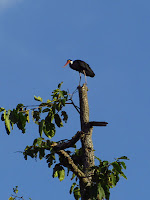We spent two days on and by the river, staying in a small lodge, Myne Resort, near Kampong Bilit. The lodge was made up of a series of little villas and a larger, common area comprising the reception, bar, dining area and sundeck all in one. It was situated right at the turn of the river, at the bottom of the "U" (photo was taken from above our lodge, which is however hidden from view). Birds sing in the trees (only saw one bird though, a sharma bird), and wild boar come to the doorstep (we saw a pack of nine our second night there). Indeed, I have not been this close to nature for a while. And I found out that in the middle of the rainforest, there is really not much internet access available. Probably a good thing, too.
We made a total of three river trips, two in the evening and one in the morning. Our party comprised another group of six people (a couple and the parents on either side), two guides and of course the boatman. The boatman clearly had spent his life on the river, and was the fastest and best at spotting animals. The guides were quick too, able to glimpse the tiny, hardly-moving bird on the tree top or the snake in the middle of the tree when I was craning my neck and trying to see something in the middle of the bushes. We were reasonably fortunate, in that we saw a fair number of birds and animals:
- crocodiles (including one baby crocodile)
- monitor lizards
- cat snake
- proboscis monkeys (I feel lucky to have caught a proboscis in mid-leap. In general, unfortunately, my photos were taken from a distance in the evening light and so not very clear)
- one orang utan and baby (see last post)
- any number of macaques, including up close
- one elephant (sadly I only got a shot of its rear)
- hornbills (rhinocerous, great and oriental pied)
- kingfishers
- herons (many types) and the Storm's Stork
- birds of prey, including the oriental darter, serpent-eagle, brahminy kite
As mentioned before, wildlife spotting is not something I normally do. But I savoured the anticipation of wondering what lay ahead, around the bend of the river, and thrilled with each new sighting of a bird or animal.
At another level, I was pleasantly surprised each time I got a fairly decent photo of a bird or an animal. This was the first time I brought out my new travelzoom camera, and I am glad I did because this was one trip where the longer zoom proved invaluable. Of course, I have a long way to go before any of my photos make it to any nature magazine. It's tough, getting just the right angle at just the right moment. But I did learn a few tricks, eg zoom in but give the animal room to move (there's a headless heron taking off in one of my photos, could hv been a great shot except for that); go for continuous shooting and KEEP the finger ON the button; and don't wait for the perfect shot JUST GO FOR IT!
Following our two days by the Kinabatangan, we made our way back to Kota Kinabalu by way of Sandakan - thus seeing both the current and former capitals of Sabah (or North Borneo, as it used to be called). We found a bookshop, Borneo Books, in Kota Kinabalu - really an excellent resource (as is their website) for books on Borneo and indeed the wildlife of Southeast Asia. This, followed by a nice breakfast of nasi lemak and Old Town coffee the next morning, made a nice close to this short trip to Borneo.













